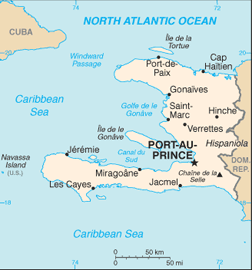| Haiti Information |
Population: 9,035,536 Dialing Code: +509 Languages: French (official), Creole (official) Religions: Roman Catholic 80%, Protestant 16% (Baptist 10%, Pentecostal 4%, Adventist 1%, other 1%), none 1%, other 3% Internet TLD: .ht Located: Caribbean, western one-third of the island of Hispaniola, between the Caribbean Sea and the North Atlantic Ocean, west of the Dominican Republic Area: 27,750 sq km Residents with HIV: 120,000 Literacy: 52.9% Comparative Size: slightly smaller than Maryland Nationality Noun: Haitian(s) Nationality Adjective: Haitian |

Haiti is a Caribbean destination occupying the western side of Hispaniola island. Dominican Republic make up the other part of the island. Haiti is surrounded by the North Atlantic Ocean on the north and the Caribbean Sea on the south. Well known explorer Columbus was the first European to discover Hispaniola in 1492. Thereafter, it came under Spanish control. However, Haiti was taken over by France in 1697. It became a republic in 1804 after a slave revolution ousted France. It was occupied by America between 1915 and 1934. For most of the later part of 20th Century, the country reeled under brutal dictatorship of Francois Duvalier. Political unrest and high crime rates have come in the way of Haiti realizing its full tourism potential.
Haiti has a vibrant culture, an impressive architectural wealth and enchanting natural beauty. Sans-Souci Palace and Citadelle la Ferriere, both located in Milot near the country's second largest city, Cap-Haitien, are important monuments of the country. Sans-Souci Palace, also called the Caribbean Versailles, was the royal residence of King Henri Christophe. The Citadelle la Ferriere is a majestic fortress built on the mountains by Henri Christophe after the French were ousted. Other attractions of Cap-Haitian, on the northern coast where Columbus is thought to have landed first after he discovered Hispaniola, include its Spanish style building and beautiful beaches.
Labadee Beach (near Cap-Haitien) is excellent for swimming, sunbathing and snorkeling. White sands of the Raymond Les Bains Beach, Ti-Mouillage Beach, Cayes-Jacmel Beach and Cyvadier Plage Beach (all near Jacmel) are other popular beach attractions of Haiti.
Jacmel, on the country's southern coast, is a picturesque township known for its elegant Victorian palaces. Spectacular Bassins Bleus, where three pools are linked by waterfalls, lies near this town. Jacmel is also a voodoo hub with many interesting temples. Parc Macaya, Haiti's most well known national park, offers unique hiking experience through lush mountains and rainforests. Kenscoff is a popular summer resort.
Port-au-Prince, the capital of Haiti, is a bustling city. The Iron Market, Museum of Haitian Art, Statue of the Unknown Slave, Gingerbread Houses and Defly Mansion are important landmarks of this city. Petionville, the city's suberb, offers excellent nightlife.

 Planning a short visit? Check out
Planning a short visit? Check out 
